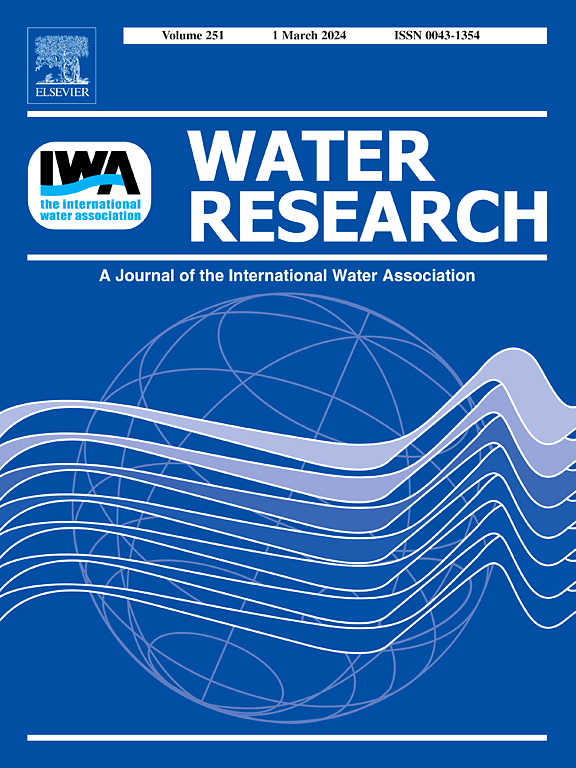Breakpoint electrochlorination in ammonia removal: Unveiling the impact of convective mass transfer
IF 12.4
1区 环境科学与生态学
Q1 ENGINEERING, ENVIRONMENTAL
引用次数: 0
Abstract
Breakpoint chlorination, the point at which ammonia is completely oxidized by chlorine to nitrogen gas, may occur during electrochemical water treatment due to the simultaneous abundance of inorganic nitrogen species and chloride ions in many water matrices. Nevertheless, little is known about the difference between the chemical breakpoint chlorination and electrochemical ammonia abatement as well as the impact of the electrode-electrolyte interface that drives the breakpoint electrochlorination. This study investigates the influence of the interface on ammonia oxidation by comparing indirect breakpoint electrochlorination with the chemical approach and by examining the impact of varying convective mass transfer on breakpoint electrochlorination. Our results revealed that, under identical conditions and bulk pH, breakpoint electrochlorination releases much lower residual chlorine species in the bulk solution before ammonia is oxidized, as compared to chemical breakpoint chlorination. It was observed that lower convective mass transfer not only accelerates ammonia removal but also increases the chlorine evolution reaction. Results from a closed divided cell experiment confirmed that chlorine evolution is enhanced under lower convective mass transfer, which suggests a relevant role of species distribution within electrode-electrolyte interface. We hypothesize that this effect may be due to a more acidic local pH under lower mass transfer conditions, which favors chlorine evolution over oxygen evolution reaction. These findings provide insights into the fundamental differences of chemical breakpoint chlorination and indirect breakpoint electrochlorination. The results can guide operating strategies for electrochemical water treatment that can potentially reduce energy consumption by lowering flow speeds, while achieving higher chlorine yield and faster ammonia removal.
断点电氯化除氨:揭示对流传质的影响
在电化学水处理过程中,由于许多水基质中同时存在大量的无机氮和氯离子,氨被氯完全氧化成氮气的断点氯化反应可能发生。然而,人们对化学断点氯化和电化学氨减排之间的区别以及驱动断点电氯化的电极-电解质界面的影响知之甚少。本研究通过比较间接断点电氯化与化学方法,考察不同对流传质对断点电氯化的影响,探讨界面对氨氧化的影响。我们的研究结果表明,在相同的条件和体积pH下,与化学断点氯化相比,断点电氯化在氨氧化前释放的体积溶液中的余氯物质要少得多。结果表明,较低的对流传质不仅加快了氨的脱除,而且增加了析氯反应。封闭分裂池实验结果证实,在较低的对流传质下,氯的析出增强,这表明电极-电解质界面内的物质分布有相关作用。我们假设这种影响可能是由于在较低的传质条件下,更酸性的局部pH值,有利于氯析出而不是氧析出反应。这些发现为化学断点氯化和间接断点电氯化的根本区别提供了见解。结果可以指导电化学水处理的操作策略,可以通过降低流速来降低能耗,同时实现更高的氯收率和更快的氨去除。
本文章由计算机程序翻译,如有差异,请以英文原文为准。
求助全文
约1分钟内获得全文
求助全文
来源期刊

Water Research
环境科学-工程:环境
CiteScore
20.80
自引率
9.40%
发文量
1307
审稿时长
38 days
期刊介绍:
Water Research, along with its open access companion journal Water Research X, serves as a platform for publishing original research papers covering various aspects of the science and technology related to the anthropogenic water cycle, water quality, and its management worldwide. The audience targeted by the journal comprises biologists, chemical engineers, chemists, civil engineers, environmental engineers, limnologists, and microbiologists. The scope of the journal include:
•Treatment processes for water and wastewaters (municipal, agricultural, industrial, and on-site treatment), including resource recovery and residuals management;
•Urban hydrology including sewer systems, stormwater management, and green infrastructure;
•Drinking water treatment and distribution;
•Potable and non-potable water reuse;
•Sanitation, public health, and risk assessment;
•Anaerobic digestion, solid and hazardous waste management, including source characterization and the effects and control of leachates and gaseous emissions;
•Contaminants (chemical, microbial, anthropogenic particles such as nanoparticles or microplastics) and related water quality sensing, monitoring, fate, and assessment;
•Anthropogenic impacts on inland, tidal, coastal and urban waters, focusing on surface and ground waters, and point and non-point sources of pollution;
•Environmental restoration, linked to surface water, groundwater and groundwater remediation;
•Analysis of the interfaces between sediments and water, and between water and atmosphere, focusing specifically on anthropogenic impacts;
•Mathematical modelling, systems analysis, machine learning, and beneficial use of big data related to the anthropogenic water cycle;
•Socio-economic, policy, and regulations studies.
 求助内容:
求助内容: 应助结果提醒方式:
应助结果提醒方式:


